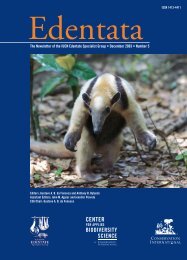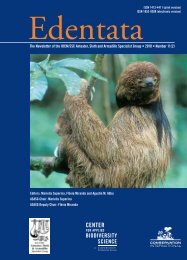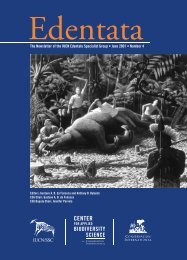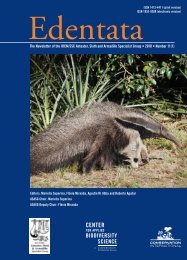Edentata 7 - Anteater, Sloth & Armadillo Specialist Group
Edentata 7 - Anteater, Sloth & Armadillo Specialist Group
Edentata 7 - Anteater, Sloth & Armadillo Specialist Group
- No tags were found...
You also want an ePaper? Increase the reach of your titles
YUMPU automatically turns print PDFs into web optimized ePapers that Google loves.
The Illegal Traffic in <strong>Sloth</strong>s and Threats to Their<br />
Survival in Colombia<br />
Sergio Moreno<br />
Tinka Plese<br />
Introduction<br />
The illegal trade in wildlife is driven by the high<br />
demand in national and international urban centers,<br />
making wildlife trafficking the third most lucrative<br />
criminal enterprise in Colombia, after the trade in<br />
weapons and drugs (CITES, 2005; Rodríguez and<br />
Echeverry, 2005). Together with the swift and pervasive<br />
destruction of tropical forests, this places many<br />
of the species reliant on these ecosystems in danger<br />
of extinction.<br />
This report is based on our observations at the UNAU<br />
Foundation sloth rehabilitation center during its first<br />
five years of operation, from 2000 to 2005, in the city<br />
of Medellín. Here we show how independent pressures<br />
have combined to threaten the survival of sloths<br />
in Colombia.<br />
<strong>Sloth</strong>s of Colombia<br />
Three species of sloths are known from Colombia<br />
(Wetzel, 1982). The brown-throated three-toed<br />
sloth, Bradypus variegatus (Schinz, 1825) inhabits<br />
both Pacific and Amazonian lowland rainforest and<br />
the Caribbean savanna dry forest (pers. obs.) (Fig.<br />
1). Hoffman’s two-toed sloth, Choloepus hoffmanni<br />
(Peters, 1859) is sympatric in the north with B. variegatus,<br />
sharing the Pacific rainforest and the Caribbean<br />
savanna dry forest, but is also found in Andean<br />
montane forest (pers. obs.). The southern two-toed<br />
sloth, Choloepus didactylus (Linnaeus, 1758) is<br />
sympatric in the south with B. variegatus, sharing<br />
the lowland Amazonian rainforest (Wetzel, 1982;<br />
Eisenberg, 1989; Emmons and Feer, 1999; Fonseca<br />
and Aguiar, 2004) but this species has been littlestudied<br />
in Colombia. The available habitat of these<br />
species is limited primarily by the extent of continuous<br />
canopy within natural forest (Montgomery and<br />
Sunquist, 1978).<br />
Previous authors have assumed the distribution of<br />
B. variegatus to include nearly the entire lowland territory<br />
of Colombia (Wetzel, 1982; Eisenberg, 1989;<br />
Emmons and Feer, 1999; Fonseca and Aguiar, 2004).<br />
However, we have developed what we believe to be a<br />
more accurate and detailed assessment of its range,<br />
based on interviews with local hunters, government<br />
officials and other researchers, as well as personal<br />
observations and our efforts to track the origin of<br />
confiscated animals. Based on this information, we<br />
believe that variegated sloths are limited to some areas<br />
of the northern Caribbean region, certain localities in<br />
the inter-Andean valleys, and the Pacific and Amazonian<br />
regions. We have combined presence data<br />
from Anderson and Handley (2001) with our own<br />
unpublished data to produce a preliminary model<br />
of distribution using BIOCLIM (Busby, 1991) and<br />
DIVA-GIS (Hijmans, 2005) that we believe presents<br />
the probable current distribution of B. variegatus<br />
(Fig. 2).<br />
C. hoffmanni has a wider distribution, ranging from<br />
the northern Caribbean coast to the south along the<br />
Pacific coast, as well as in the central Andean regions<br />
(Wetzel, 1982). In Colombia there are two distinct<br />
phenotypes of C. hoffmanni; one is found in lower,<br />
warmer areas below 1500 m, while the other is typical<br />
of higher and cooler zones between 1500 and<br />
3000 m (Moreno, 2003b). These phenotypes may<br />
correspond to the subspecies C. h. capitalis and<br />
C. h. agustinus, respectively (Wetzel, 1982). C. didactylus<br />
has been reported from the Orinoco and Amazon<br />
regions (Wetzel, 1982; Eisenberg, 1989; Emmons and<br />
Feer, 1999), but this species has been little studied<br />
in Colombia.<br />
FIGURE 1. Main natural regions of Colombia. Map developed from<br />
IAvH (2005a) and IGAC (2002). Arid and semiarid areas correspond<br />
to lowlands dominated by xerophytic or subxerophytic vegetation.<br />
Savannahs are lowlands with marked dry-wet seasons; they are characterized<br />
by shrub vegetation and abundant wetlands. The Andean<br />
region is comprised of a great diversity of montane ecosystems with<br />
multiple vegetation assemblies, ranging from 500 to 3900 m above<br />
sea level. Rainforest is evergreen hygrophilous with exuberant stratified<br />
vegetation, rich in lianas and epiphytes. Transformed areas are<br />
primarily used for intensive agriculture and ranching (IGAC, 2002).<br />
10<br />
<strong>Edentata</strong> no. 7 • May 2006














